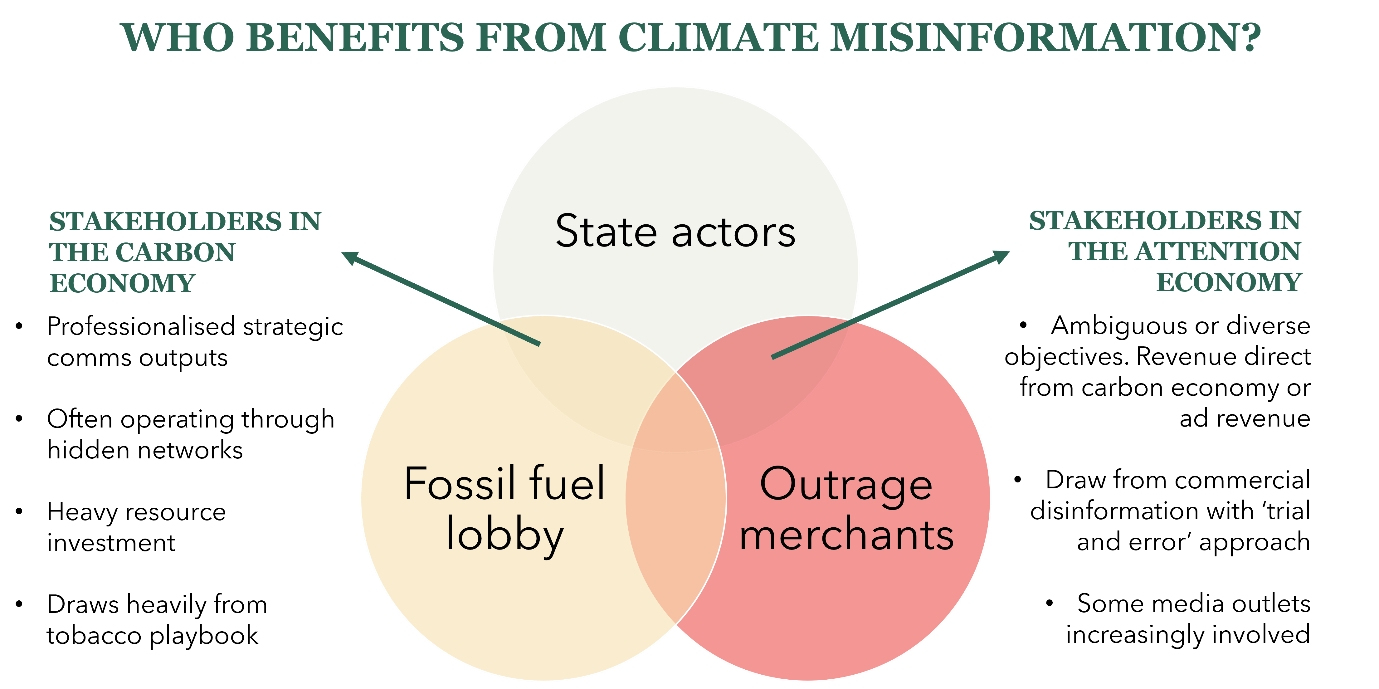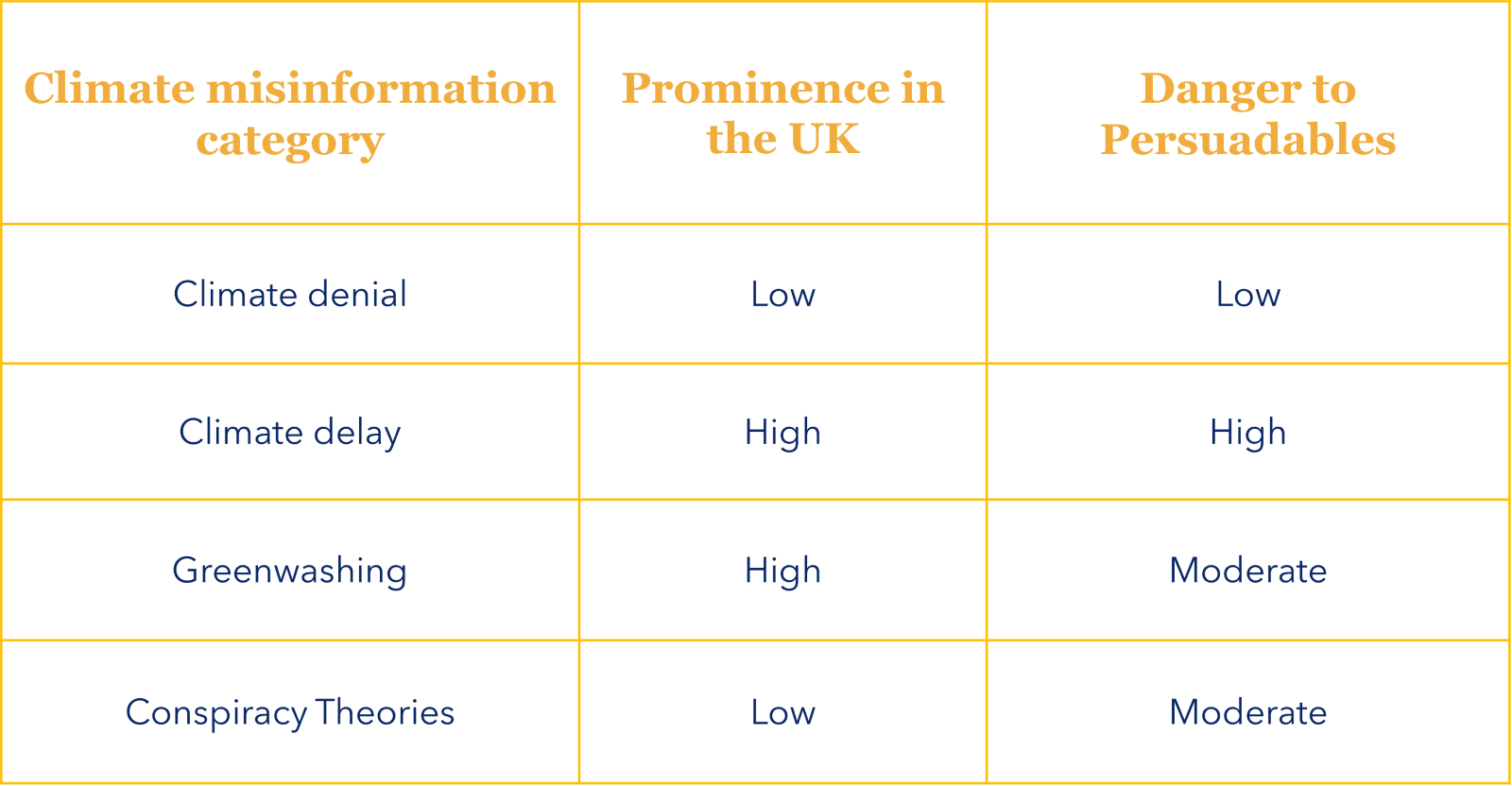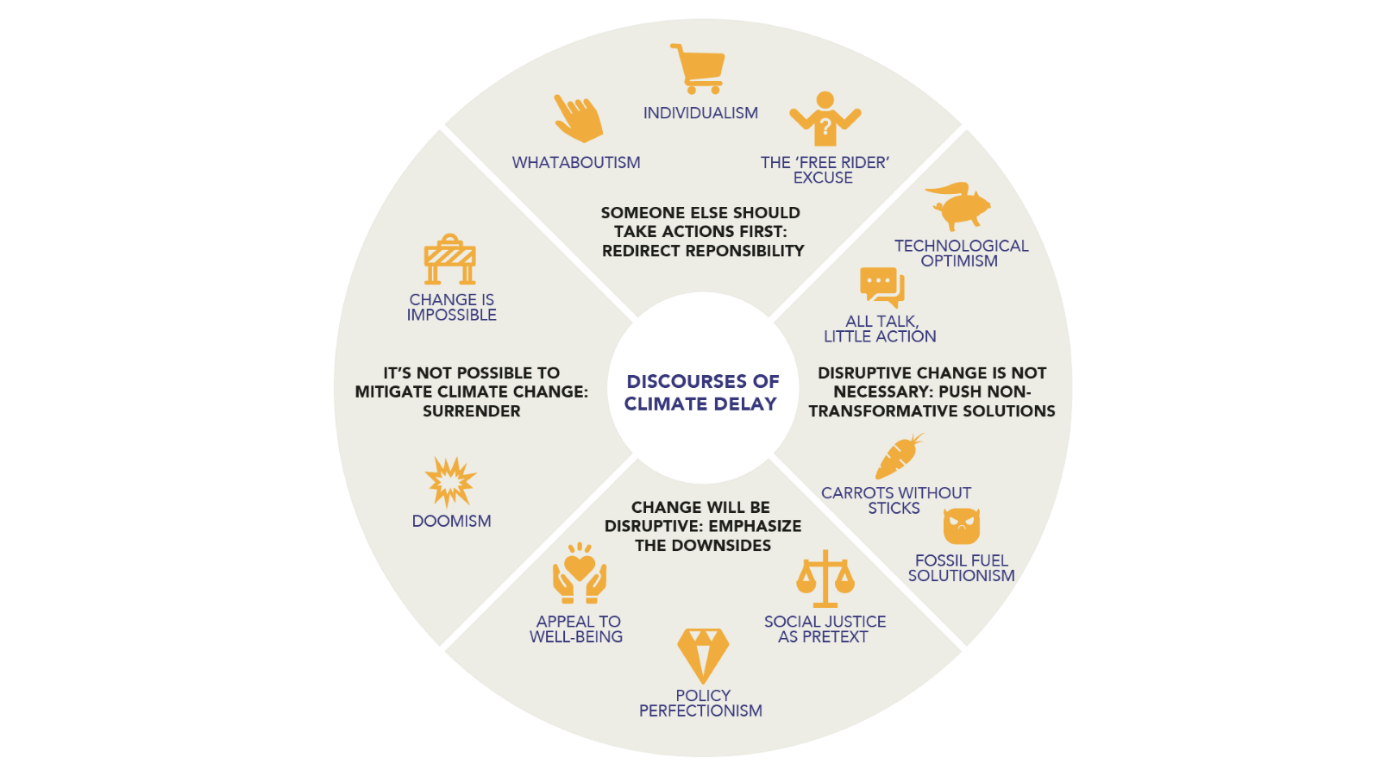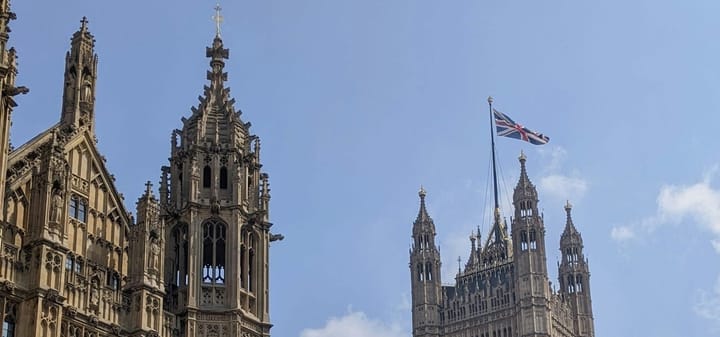Strategic Guide: What is climate misinformation?

The UK has made international commitments to stay within 2 degrees and preferably 1.5 degrees of global warming. To honour this, the UK needs to decarbonise rapidly – known in some circles as ‘climate action’. However, climate change disinformation and misinformation are a major threat to this activity. They distort public perception of climate science and paths to decarbonisation
In this post, we will cover all you need to know about climate misinformation, including:
- What’s going on? What is the difference between climate misinformation and disinformation? What is the definition of climate misinformation? Plus, who creates and spreads climate misinformation in the UK and why?
- Who’s involved? What are the different types of climate misinformation and which ones are most convincing to Persuadables? We cover climate denial, climate delay, greenwashing and conspiracy theories.
- How to get ahead. What can we do about climate misinformation?
This threat alert was originally published in September 2021 and has been last updated in November 2023.
What's going on?
What is the difference between climate misinformation and disinformation? What is the definition of climate misinformation? Who creates and spreads climate misinformation in the UK and why?
What is the difference between climate misinformation and disinformation?
The difference is intent. Those sharing or creating climate misinformation may not realise the information is false. However, disinformation spreaders share false information deliberately.

In practice, intent is very hard to prove, although not impossible. For example, ongoing literature identifies several major fossil fuel companies’ intentions to spread doubt about climate science, despite internal documents demonstrating a very detailed understanding of the same science.
What is the definition of climate misinformation?
At ACT Climate Labs we use the same definition as Climate Action Against Disinformation (CAAD) – a coalition of experts in climate and disinformation.
According to CAAD, climate disinformation and misinformation refers to deceptive or misleading content that:
- Undermines the existence or impacts of climate change, the unequivocal human influence on climate change, or the need for corresponding urgent action according to the IPCC scientific consensus and in line with the goals of the Paris Climate Agreement .
- Misrepresents scientific data, including by omission or cherry-picking, to erode trust in climate science, climate-focused institutions, experts, and solutions.
- Falsely publicises efforts as supportive of climate goals that, in fact, contribute to global warming or contravene the scientific consensus on mitigation or adaptation.
In summary, climate misinformation counts as any deceptive or misleading content that undermines the existence or severity of climate change, our contribution to it or the need for corresponding action. It also covers climate change greenwashing – the act of exaggerating or lying about one’s decarbonisation initiatives.
Anything outside this definition could be termed adversarial or misleading content but isn’t necessarily misinformation. That said, a lot of analysis advice we provide on this website is about adversarial and misleading content too.
Who creates and shares climate misinformation and why?
Given the scale and urgency of climate change, why create disinformation or share misinformation on climate change in the first place? Experts have narrowed it down to two main incentives:
- Extending the life of fossil fuels and business-as-usual profits.
- Earning revenue, clout or support for related causes by exploiting the attention economy. That is, exploiting the tendency to gain more attention online and offline by spreading highly emotional or controversial content.

Who's involved?
What are the different types of climate misinformation and which ones are most convincing to Persuadables? We cover climate denial, climate delay, greenwashing and conspiracy theories.
In practice, Persuadables – the people most vulnerable to climate misinformation in the UK – will see misinformation from a diverse range of sources: companies, governments, politicians, media outlets, organised groups online and offline, as well as online ‘chancers’ who just want to make a bit of ad revenue.
The roughly 69% of Brits who are not climate activists nor deniers. They are a diverse group, but what brings them together is their position on climate action. Generally speaking they are yet to be convinced on it, but can be – hence the name “Persuadables”.
The different types of climate misinformation
There are various taxonomies of climate misinformation out there. Yet when it comes to Persuadables, it’s helpful to think of four broad categories:

Climate Denial
When people hear “climate misinformation”, they usually think of this first. Climate denial includes narratives that deny the existence of climate change, humans’ contribution to it, or the severity of its impacts.
Climate denial is more than just white lies about the science. It includes:
- Outright denial. ‘Humans have no effect, it’s just sun cycles!’
- Interpretive denial, where scientific facts are not contested, but interpreted in ways that distort reality. ‘The climate has always changed! It’s natural!’
- Implicatory denial, where climate science is avoided altogether, but implications of the science are minimised or denied. ‘It’s all very well for elites to worry about climate change while the rest of us are concerned with real world problems!’
Climate delay
Delay messaging usually accepts the existence of human-induced climate change, but seeks to block or slow down measures to decarbonise. For this reason it is often focused on specific policies and technologies. Responding to this kind of misinformation can be tricky, because the knowledge base covers a wide range of different policies, technologies and current events. Based on our analysis, it is by far the most common and effective form of climate misinformation seen in the UK.

A very popular climate delay frame in the UK is 'The Cost Of Net Zero'. It generally cherry-picks isolated, short-term costs (financial or otherwise) of climate action. Meanwhile, it ignores long-term costs of not taking action, or short or long-term benefits of taking action. Read more in our Cost of Net Zero guide.
A frame is the way an issue, story or argument is presented. It helps us interpret what we see through a specific lens and form our own narratives. The same issue may feel very different depending on the framing. For example, whether the issue is important or unimportant, whether it is a personal or shared social concern, or which solutions we support to fix a problem.
A popular tactic in climate delay is taking advantage of culture wars. A culture war is a cultural conflict between social groups where one wants their values, beliefs and practices to dominate. Built up over years, climate culture wars exploit feelings of scarcity, loss, unfairness and encourage blame and othering of groups that are allegedly ideologically opposed. This results in negative sentiment towards certain messengers such as climate activists, climate NGOs, government institutions, or anyone seen as ‘elite’.
A popular frame exploiting culture wars is the eco-hypocrite frame, where any unsustainable action taken by someone publicly trying to fix the problem is used as evidence that they don’t really care and are out of touch with the needs of ordinary people. Usually, every COP conference starts with popular social media posts bemoaning private jets flying in. A legitimate concern? Very much so. A reason to not take climate action at all? Not so much.
Greenwashing
Greenwashing is presenting your company or product as more environmentally friendly than it really is. Put another way – marketing spin. This is technically a form of climate delay but it stands out as its own issue due to multi-million dollar marketing and lobbying budgets committed to it – especially from the fossil fuel industry.
Research shows that while members of the public are usually good at spotting misleading information on products, research indicates that we are more susceptible to misleading ideas. We are more likely to believe promotions that cater to our intrinsic values, or that adopt “executional greenwashing” – using images and sounds of nature, clean energy and happy communities instead of making any specific claims about products themselves.
Greenwashing may be making Persuadables too complacent about our ability to fix climate change, but more research needs to be done to better understand it.
Conspiracy
People that believe conspiracy theories are unfairly branded as fanatics. In fact, up to 1 in 3 Britons may already believe some kind of conspiracy; and at the height of its popularity, 1 in 4 believed some kind of QAnon conspiracy.
When it comes to climate conspiracy theories, the most popular is the age-hold “climate change is a hoax”. This is believed by around 7-8% of Brits. However, conspiracies around climate change seem to be growing in number:
- In 2020, during the height of the pandemic, fears grew about "climate lockdowns".
- In 2022 the World Climate Declaration (a variation of "climate change is a hoax") was one of the most popular misinformation spikes online.
- In 2023 Oxford became a hotspot for the international conspiracy surrounding 15-minute cities.
As the impacts of climate change become more visible in the UK, the risk is that Persuadables will turn to alternative explanations not based in climate science to cope. Recent studies on TikTok and Instagram clearly outline the risk.
Read more about Persuadables and climate conspiracy theories at our dedicated briefing.
How to get ahead.
What can we do about climate misinformation?
Communications and campaigning professionals hold a lot of power. With the right frames and tactics, we can:
- Inoculate Persuadables against climate misinformation before they see it, preferably through a combination of organic and paid media.
- Reframe action for decarbonisation in a way that is attractive to Persuadables.
- Use Fact, Myth, Fallacy to effectively rebut against the most popular climate misinformation claims.




Comments ()